PROBLEMS
WORKING WITH THE FIGURES
Question 17.1
Based on Table 17-1, how would you categorize the following genomes? (Letters H through J stand for four different chromosomes.)

Question 17.2
Based on Figure 17-4, how many chromatids are in a trivalent?
Question 17.3
Based on Figure 17-5, if colchicine is used on a plant in which 2n = 18, how many chromosomes would be in the abnormal product?
Question 17.4
Basing your work on Figure 17-7, use colored pens to represent the chromosomes of the fertile amphidiploid.
Question 17.5
If Emmer wheat (Figure 17-9) is crossed to another wild wheat CC (not shown), what would be the constitution of a sterile product of this cross? What amphidiploid could arise from the sterile product? Would the amphidiploid be fertile?
656
Question 17.6
In Figure 17-12, what would be the constitution of an individual formed from the union of a monosomic from a first-
Question 17.7
In Figure 17-14, what would be the expected percentage of each type of segregation?
Question 17.8
In Figure 17-19, is there any difference between the inversion products formed from breakage and those formed from crossing over?
Question 17.9
Referring to Figure 17-19, draw a diagram showing the process whereby an inversion formed from crossing over could generate a normal sequence.
Question 17.10
In Figure 17-21, would the recessive fa allele be expressed when paired with deletion 264-
Question 17.11
Look at Figure 17-22 and state which bands are missing in the cri du chat deletion.
Question 17.12
In Figure 17-25, which species is most closely related to the ancestral yeast strain? Why are genes 3 and 13 referred to as duplicate?
Question 17.13
Referring to Figure 17-26, draw the product if breaks occurred within genes A and B.
Question 17.14
In Figure 17-26, the bottom panel shows that genes B and C are oriented in a different direction (note the promoters). Do you think this difference in orientation would affect their functionality?
Question 17.15
In Figure 17-28, what would be the consequence of a crossover between the centromere and locus A?
Question 17.16
Based on Figure 17-30, are normal genomes ever formed from the two types of segregation? Are normal genomes ever formed from an adjacent-
Question 17.17
Referring to Figure 17-32, draw an inviable product from the same meiosis.
Question 17.18
Based on Figure 17-35, write a sentence stating how translocation can lead to cancer. Can you think of another genetic cause of cancer?
Question 17.19
Looking at Figure 17-36, why do you think the signal ratio is so much higher in the bottom panel?
Question 17.20
Using Figure 17-37, calculate what percentage of conceptions are triploid. The same figure shows XO in the spontaneous-
BASIC PROBLEMS
Question 17.21
In keeping with the style of Table 17-1, what would you call organisms that are MM N OO; MM NN OO; MMM NN PP?
Question 17.22
A large plant arose in a natural population. Qualitatively, it looked just the same as the others, except much larger. Is it more likely to be an allopolyploid or an autopolyploid? How would you test that it was a polyploid and not just growing in rich soil?
Question 17.23
Is a trisomic an aneuploid or a polyploid?
Question 17.24
In a tetraploid B/B/b/b, how many quadrivalent possible pairings are there? Draw them (see Figure 17-5).
Question 17.25
Someone tells you that cauliflower is an amphidiploid. Do you agree? Explain.
Question 17.26
Why is Raphanobrassica fertile, whereas its progenitor wasn’t?
Question 17.27
In the designation of wheat genomes, how many chromosomes are represented by the letter B?
Question 17.28
How would you “re-
Question 17.29
How would you make a monoploid plantlet by starting with a diploid plant?
Question 17.30
A disomic product of meiosis is obtained. What is its likely origin? What other genotypes would you expect among the products of that meiosis under your hypothesis?
Question 17.31
Can a trisomic A/A/a ever produce a gamete of genotype a?
Question 17.32
Which, if any, of the following sex-
Question 17.33
Why are older expectant mothers routinely given amniocentesis or CVS?
Question 17.34
In an inversion, is a 5′ DNA end ever joined to another 5′ end? Explain.
Question 17.35
If you observed a dicentric bridge at meiosis, what rearrangement would you predict had taken place?
Question 17.36
Why do acentric fragments get lost?
Question 17.37
Diagram a translocation arising from repetitive DNA. Repeat for a deletion.
Question 17.38
From a large stock of Neurospora rearrangements available from the fungal genetics stock center, what type would you choose to synthesize a strain that had a duplication of the right arm of chromosome 3 and a deletion for the tip of chromosome 4?
Question 17.39
You observe a very large pairing loop at meiosis. Is it more likely to be from a heterozygous inversion or heterozygous deletion? Explain.
Question 17.40
A new recessive mutant allele doesn’t show pseudodominance with any of the deletions that span Drosophila chromosome 2. What might be the explanation?
Question 17.41
Compare and contrast the origins of Turner syndrome, Williams syndrome, cri du chat syndrome, and Down syndrome. (Why are they called syndromes?)
Question 17.42
List the diagnostic features (genetic or cytological) that are used to identify these chromosomal alterations:
Deletions
Duplications
Inversions
Reciprocal translocations
Question 17.43
The normal sequence of nine genes on a certain Drosophila chromosome is 123 · 456789, where the dot represents the centromere. Some fruit flies were found to have aberrant chromosomes with the following structures:
123 · 476589
123 · 46789
1654 · 32789
123 · 4566789
Name each type of chromosomal rearrangement, and draw diagrams to show how each would synapse with the normal chromosome.
Question 17.44
The two loci P and Bz are normally 36 m.u. apart on the same arm of a certain plant chromosome. A paracentric inversion spans about one-
heterozygous for the paracentric inversion?
homozygous for the paracentric inversion?
Question 17.45
As stated in Solved Problem 2, recessive mutation in certain mice called waltzers causes them to execute bizarre steps. W. H. Gates crossed waltzers with pure-
Question 17.46
A salivary-
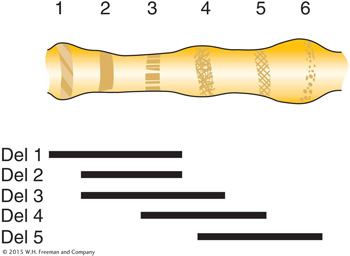
Recessive alleles a, b, c, d, e, and f are known to be in the region, but their order is unknown. When the deletions are combined with each allele, the following results are obtained:
|
a |
b |
c |
d |
e |
f |
|
|---|---|---|---|---|---|---|
|
Del 1 |
− |
− |
− |
+ |
+ |
+ |
|
Del 2 |
− |
+ |
− |
+ |
+ |
+ |
|
Del 3 |
− |
+ |
− |
+ |
− |
+ |
|
Del 4 |
+ |
+ |
− |
− |
− |
+ |
|
Del 5 |
+ |
+ |
+ |
− |
− |
− |
In this table, a minus sign means that the deletion uncovers the recessive allele (the recessive phenotype is observed), and a plus sign means that the corresponding wild-
Question 17.47
A fruit fly was found to be heterozygous for a paracentric inversion. However, obtaining flies that were homozygous for the inversion was impossible even after many attempts. What is the most likely explanation for this inability to produce a homozygous inversion?
Question 17.48
Orangutans are an endangered species in their natural environment (the islands of Borneo and Sumatra), and so a captive-

What term or terms describe the differences between these chromosomes?
Draw the chromosomes 2, paired in the first meiotic prophase, of such a hybrid orangutan. Be sure to show all the landmarks indicated in the accompanying diagram, and label all parts of your drawing.
In 30 percent of meioses, there will be a crossover somewhere in the region between bands p1.1 and q1.2. Draw the gamete chromosomes 2 that would result from a meiosis in which a single crossover occurred within band q1.1.
What fraction of the gametes produced by a hybrid orangutan will give rise to viable progeny, if these chromosomes are the only ones that differ between the parents? (Problem 48 is from Rosemary Redfield.)
658
Question 17.49
In corn, the genes for tassel length (alleles T and t) and rust resistance (alleles R and r) are known to be on separate chromosomes. In the course of making routine crosses, a breeder noticed that one T/t;R/r plant gave unusual results in a testcross with the double-
|
Progeny: |
T/t;R/r |
98 |
|
t/t;r/r |
104 |
|
|
T/t;r/r |
3 |
|
|
t/t;R/r |
5 |
|
|
Corncobs: |
Only about half as many seeds as usual |
|
What key features of the data are different from the expected results?
State a concise hypothesis that explains the results.
Show genotypes of parents and progeny.
Draw a diagram showing the arrangement of alleles on the chromosomes.
Explain the origin of the two classes of progeny having three and five members.
 Unpacking Problem 49
Unpacking Problem 49
What do a “gene for tassel length” and a “gene for rust resistance” mean?
Does it matter that the precise meaning of the allelic symbols T, t, R, and r is not given? Why or why not?
How do the terms gene and allele, as used here, relate to the concepts of locus and gene pair?
What prior experimental evidence would give the corn geneticist the idea that the two genes are on separate chromosomes?
What do you imagine “routine crosses” are to a corn breeder?
What term is used to describe genotypes of the type T/t;R/r?
What is a “pollen parent”?
What are testcrosses, and why do geneticists find them so useful?
What progeny types and frequencies might the breeder have been expecting from the testcross?
Describe how the observed progeny differ from expectations.
What does the approximate equality of the first two progeny classes tell you?
What does the approximate equality of the second two progeny classes tell you?
What were the gametes from the unusual plant, and what were their proportions?
Which gametes were in the majority?
Which gametes were in the minority?
Which of the progeny types seem to be recombinant?
Which allelic combinations appear to be linked in some way?
How can there be linkage of genes supposedly on separate chromosomes?
What do these majority and minority classes tell us about the genotypes of the parents of the unusual plant?
What is a corncob?
What does a normal corncob look like? (Sketch one and label it.)
What do the corncobs from this cross look like? (Sketch one.)
What exactly is a kernel?
What effect could lead to the absence of half the kernels?
Did half the kernels die? If so, was the female or the male parent the reason for the deaths?
Now try to solve the problem.
Question 17.50
A yellow body in Drosophila is caused by a mutant allele y of a gene located at the tip of the X chromosome (the wild-
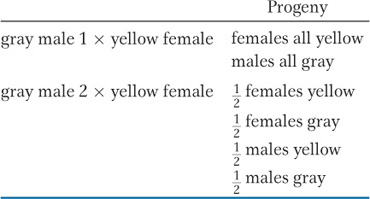
Explain the origin and crossing behavior of gray male 1.
Explain the origin and crossing behavior of gray male 2.
Question 17.51
In corn, the allele Pr stands for green stems, pr for purple stems. A corn plant of genotype pr/pr that has standard chromosomes is crossed with a Pr/Pr plant that is homozygous for a reciprocal translocation between chromosomes 2 and 5. The F1 is semisterile and phenotypically Pr. A backcross with the parent with standard chromosomes gives 764 semisterile Pr, 145 semisterile pr, 186 normal Pr, and 727 normal pr. What is the map distance between the Pr locus and the translocation point?
659
Question 17.52
Distinguish among Klinefelter, Down, and Turner syndromes. Which syndromes are found in both sexes?
Question 17.53
Show how you could make an allotetraploid between two related diploid plant species, both of which are 2n = 28.
Question 17.54
In Drosophila, trisomics and monosomics for the tiny chromosome 4 are viable, but nullisomics and tetraso-
b+/b/b × b/b
b+/b+/b × b/b
b+/b+/b × b+/b
Question 17.55
A woman with Turner syndrome is found to be colorblind (an X-
Explain the simultaneous origin of Turner syndrome and color blindness by the abnormal behavior of chromosomes at meiosis.
Can your explanation distinguish whether the abnormal chromosome behavior occurred in the father or the mother?
Can your explanation distinguish whether the abnormal chromosome behavior occurred at the first or second division of meiosis?
Now assume that a color-
blind Klinefelter man has parents with normal vision, and answer parts a, b, and c.
Question 17.56
How would you synthesize a pentaploid?
How would you synthesize a triploid of genotype A/a/a?
You have just obtained a rare recessive mutation a* in a diploid plant, which Mendelian analysis tells you is A/a*. From this plant, how would you synthesize a tetraploid (4n) of genotype A/A/a*/a*?
How would you synthesize a tetraploid of genotype A/a/a/a?
Question 17.57
Suppose you have a line of mice that has cytologically distinct forms of chromosome 4. The tip of the chromosome can have a knob (called 4K) or a satellite (4S) or neither (4). Here are sketches of the three types:
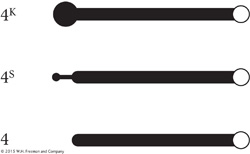
You cross a 4K/4S female with a 4/4 male and find that most of the progeny are 4K/4 or 4S/4, as expected.
However, you occasionally find some rare types as follows (all other chromosomes are normal):
4K/4K/4
4K/4S/4
4K
Explain the rare types that you have found. Give, as precisely as possible, the stages at which they originate, and state whether they originate in the male parent, the female parent, or the zygote. (Give brief reasons.)
Question 17.58
A cross is made in tomatoes between a female plant that is trisomic for chromosome 6 and a normal diploid male plant that is homozygous for the recessive allele for potato leaf (p/p). A trisomic F1 plant is backcrossed to the potato-
What is the ratio of normal-
leaved plants to potato- leaved plants when you assume that p is located on chromosome 6? What is the ratio of normal-
leaved to potato- leaved plants when you assume that p is not located on chromosome 6?
Question 17.59
A tomato geneticist attempts to assign five recessive mutations to specific chromosomes by using trisomics. She crosses each homozygous mutant (2n) with each of three trisomics, in which chromosomes 1, 7, and 10 take part. From these crosses, the geneticist selects trisomic progeny (which are less vigorous) and backcrosses them to the appropriate homozygous recessive. The diploid progeny from these crosses are examined. Her results, in which the ratios are wild type: mutant, are as follows:
|
Mutation |
|||||
|---|---|---|---|---|---|
|
Trisomic chromosome |
d |
y |
c |
h |
cot |
|
1 |
48:55 |
72:29 |
56:50 |
53:54 |
32:28 |
|
7 |
52:56 |
52:48 |
52:51 |
58:56 |
81:40 |
|
10 |
45:42 |
36:33 |
28:32 |
96:50 |
20:17 |
Which of the mutations can the geneticist assign to which chromosomes? (Explain your answer fully.)
Question 17.60
A petunia is heterozygous for the following autosomal homologs:

Draw the pairing configuration that you would see at metaphase I, and identify all parts of your diagram. Number the chromatids sequentially from top to bottom of the page.
A three-
strand double crossover occurs, with one crossover between the C and D loci on chromatids 1 and 3, and the second crossover between the G and H loci on chromatids 2 and 3. Diagram the results of these recombination events as you would see them at anaphase I, and identify all parts of your diagram. 660
Draw the chromosome pattern that you would see at anaphase II after the crossovers described in part b.
Give the genotypes of the gametes from this meiosis that will lead to the formation of viable progeny. Assume that all gametes are fertilized by pollen that has the gene order A B C D E F G H I.
Question 17.61
Two groups of geneticists, in California and in Chile, begin work to develop a linkage map of the medfly. They both independently find that the loci for body color (B = black, b = gray) and eye shape (R = round, r = star) are linked 28 m.u. apart. They send strains to each other and perform crosses; a summary of all their findings is shown here:
|
Cross |
F1 |
Progeny of F1 × any b r/b r |
|
|---|---|---|---|
|
B R/B R (Calif.) |
B R/b r |
B R/b r |
36% |
|
× b r/b r (Calif.) |
b r/b r |
36 |
|
|
B r/b r |
14 |
||
|
b R/b r |
14 |
||
|
B R/B R (Chile) |
B R/b r |
B R/b r |
36 |
|
× b r/b r (Chile) |
b r/b r |
36 |
|
|
B r/b r |
14 |
||
|
b R/b r |
14 |
||
|
B R/B R (Calif.) |
B R/b r |
B R/b r |
48 |
|
× b r/b r (Chile) or |
b r/b r |
48 |
|
|
b r/b r (Calif.) |
B r/b r |
2 |
|
|
× B R/B R (Chile) |
b R/b r |
2 |
Provide a genetic hypothesis that explains the three sets of testcross results.
Draw the key chromosomal features of meiosis in the F1 from a cross of the Californian and Chilean lines.
Question 17.62
An aberrant corn plant gives the following RF values when testcrossed:
|
Interval |
|||||
|---|---|---|---|---|---|
|
d– |
f– |
b– |
x– |
y– |
|
|
Control |
5 |
18 |
23 |
12 |
6 |
|
Aberrant plant |
5 |
2 |
2 |
0 |
6 |
(The locus order is centromere-
Propose a hypothesis to account for the abnormal recombination values and the reduced fertility in the aberrant plant.
Use diagrams to explain the origin of the recombinants according to your hypothesis.
Question 17.63
The following corn loci are on one arm of chromosome 9 in the order indicated (the distances between them are shown in map units):

C gives colored aleurone; c, white aleurone.
Bz gives green leaves; bz, bronze leaves.
Wx gives starchy seeds; wx, waxy seeds.
Sh gives smooth seeds; sh, shrunken seeds.
D gives tall plants; d, dwarf.
A plant from a standard stock that is homozygous for all five recessive alleles is crossed with a wild-
|
colored, green, starchy, smooth, tall |
360 |
|
white, bronze, waxy, shrunk, dwarf |
355 |
|
colored, bronze, waxy, shrunk, dwarf |
40 |
|
white, green, starchy, smooth, tall |
46 |
|
colored, green, starchy, smooth, dwarf |
85 |
|
white, bronze, waxy, shrunk, tall |
84 |
|
colored, bronze, waxy, shrunk, tall |
8 |
|
white, green, starchy, smooth, dwarf |
9 |
|
colored, green, waxy, smooth, tall |
7 |
|
white, bronze, starchy, shrunk, dwarf |
6 |
Propose a hypothesis to explain these results. Include
a general statement of your hypothesis, with diagrams if necessary;
why there are 10 classes;
an account of the origin of each class, including its frequency; and
at least one test of your hypothesis.
Question 17.64
Chromosomally normal corn plants have a p locus on chromosome 1 and an s locus on chromosome 5.
P gives dark green leaves; p, pale green leaves.
S gives large ears; s, shrunken ears.
An original plant of genotype P/p ; S/s has the expected phenotype (dark green, large ears) but gives unexpected results in crosses as follows:
On selfing, fertility is normal, but the frequency of p/p ; s/s types is 1/4 (not 1/16 as expected).
When crossed with a normal tester of genotype p/p; s/s, the F1 progeny are
 ; P/p ; S/s
; P/p ; S/s  ; and p/p ; s/s; fertility is normal.
; and p/p ; s/s; fertility is normal.661
Embryos (mean number)
Mating
Implanted in the uterine wall
Degeneration after implanation
Normal
Degeneration (%)
exceptional ♂ × normal ♀
8.7
5.0
3.7
37.5
normal ♂ × normal ♀
9.5
0.6
8.9
6.5
When an F1 P/p ; S/s plant is crossed with a normal p/p ; s/s tester, it proves to be semisterile, but, again, the progeny are
 ; P/p ; S/s and
; P/p ; S/s and  ; p/p ; s/s.
; p/p ; s/s.
Explain these results, showing the full genotypes of the original plant, the tester, and the F1 plants. How would you test your hypothesis?
Question 17.65
A male rat that is phenotypically normal shows reproductive anomalies when compared with normal male rats, as shown in the table in Problem 64. Propose a genetic explanation of these unusual results, and indicate how your idea could be tested.
Question 17.66
A tomato geneticist working on Fr, a dominant mutant allele that causes rapid fruit ripening, decides to find out which chromosome contains this gene by using a set of lines of which each is trisomic for one chromosome. To do so, she crosses a homozygous diploid mutant with each of the wild-
A trisomic F1 plant is crossed with a diploid wildtype plant. What is the ratio of fast-
to slow- ripening plants in the diploid progeny of this second cross if Fr is on the trisomic chromosome? Use diagrams to explain. What is the ratio of fast-
to slow- ripening plants in the diploid progeny of this second cross if Fr is not located on the trisomic chromosome? Use diagrams to explain. Here are the results of the crosses. On which chromosome is Fr, and why?
|
Trisomic chromosome |
Fast ripening: slow ripening in diploid progeny |
|---|---|
|
1 |
45:47 |
|
2 |
33:34 |
|
3 |
55:52 |
|
4 |
26:30 |
|
5 |
31:32 |
|
6 |
37:41 |
|
7 |
44:79 |
|
8 |
49:53 |
|
9 |
34:34 |
|
10 |
37:39 |
(Problem 66 is from Tamara Western.)
CHALLENGING PROBLEMS
Question 17.67
The Neurospora un-
What types of linear asci (see Chapter 4) do you predict, and in what frequencies, in a normal cross of un-
3 ad- 3 × wild type? (Specify genotypes of spores in the asci.) Most of the time such crosses behave predictably, but, in one case, a standard un-
3 ad- 3 strain was crossed with a wild type isolated from a field of sugarcane in Hawaii. The results follow:
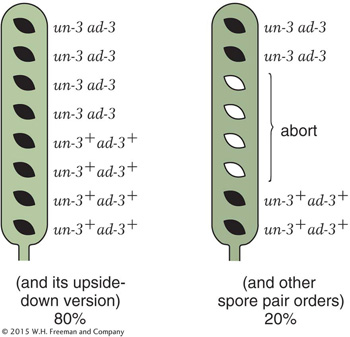
Explain these results, and state how you could test your idea. (Note: In Neurospora, ascospores with extra chromosomal material survive and are the normal black color, whereas ascospores lacking any chromosome region are white and inviable.)
Question 17.68
Two mutations in Neurospora, ad-
662
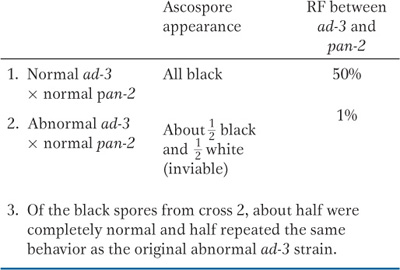
Question 17.69
Deduce the phenotypic proportions in the progeny of the following crosses of autotetraploids in which the a+/a locus is very close to the centromere. (Assume that the four homologous chromosomes of any one type pair randomly two by two and that only one copy of the a+ allele is necessary for the wild-
a+/a+/a/a × a/a/a/a
a+/a/a/a × a/a/a/a
a+/a/a/a × a+/a/a/a
a+/a+/a/a × a+/a/a/a
Question 17.70
The New World cotton species Gossypium hirsutum has a 2n chromosome number of 52. The Old World species G. thurberi and G. herbaceum each have a 2n number of 26. When these species are crossed, the resulting hybrids show the following chromosome pairing arrangements at meiosis:
|
Hybrid |
Pairing arrangement |
|---|---|
|
G. hirsutum |
13 small bivalents |
|
× G. thurberi |
+ 13 large univalents |
|
G. hirsutum |
13 large bivalents |
|
× G. herbaceum |
+ 13 small univalents |
|
G. thurberi |
13 large univalents |
|
× G. herbaceum |
+ 13 small univalents |
Interpret these observations phylogenetically, using diagrams. Clearly indicate the relationships between the species. How would you prove that your interpretation is correct?
Question 17.71
There are six main species in the Brassica genus: B. carinata, B. campestris, B. nigra, B. oleracea, B. juncea, and B. napus. You can deduce the interrelationships among these six species from the following table:
|
Species or F1 hybrid |
Chromosome number |
Number of bivalents |
Number of univalents |
|---|---|---|---|
|
B. juncea |
36 |
18 |
0 |
|
B. carinata |
34 |
17 |
0 |
|
B. napus |
38 |
19 |
0 |
|
B. juncea × B. nigra |
26 |
8 |
10 |
|
B. napus × B. campestris |
29 |
10 |
9 |
|
B. carinata × B. oleracea |
26 |
9 |
8 |
|
B. juncea × B. oleracea |
27 |
0 |
27 |
|
B. carinata × B. campestris |
27 |
0 |
27 |
|
B. napus × B. nigra |
27 |
0 |
27 |
Deduce the chromosome number of B. campestris, B. nigra, and B. oleracea.
Show clearly any evolutionary relationships between the six species that you can deduce at the chromosomal level.
Question 17.72
Several kinds of sexual mosaicism are well documented in humans. Suggest how each of the following examples may have arisen by nondisjunction at mitosis:
XX/XO (that is, there are two cell types in the body,
XX and XO)
XX/XXYY
XO/XXX
XX/XY
XO/XX/XXX
Question 17.73
In Drosophila, a cross (cross 1) was made between two mutant flies, one homozygous for the recessive mutation bent wing (b) and the other homozygous for the recessive mutation eyeless (e). The mutations e and b are alleles of two different genes that are known to be very closely linked on the tiny autosomal chromosome 4. All the progeny had a wild-
Explain what the common progeny are expected to be from cross 2.
Could the rare wild-
type female have arisen by (1) crossing over or (2) nondisjunction? Explain. The rare wild-
type female was testcrossed to a male of genotype b e/b e (cross 3). The progeny were

Which of the explanations in part b is compatible with this result? Explain the genotypes and phenotypes of the progeny of cross 3 and their proportions.
 Unpacking Problem 73
Unpacking Problem 73
Define homozygous, mutation, allele, closely linked, recessive, wild type, crossing over, nondisjunction, testcross, phenotype, and genotype.
Does this problem concern sex linkage? Explain.
How many chromosomes does Drosophila have?
Draw a clear pedigree summarizing the results of crosses 1, 2, and 3.
Draw the gametes produced by both parents in cross 1.
Draw the chromosome 4 constitution of the progeny of cross 1.
Is it surprising that the progeny of cross 1 are wild-
type phenotype? What does this outcome tell you? Draw the chromosome 4 constitution of the male tester used in cross 2 and the gametes that he can produce.
With respect to chromosome 4, what gametes can the female parent in cross 2 produce in the absence of non-
disjunction? Which would be common and which rare? Draw first-
and second- division meiotic nondisjunction in the female parent of cross 2, as well as in the resulting gametes. Are any of the gametes from part 10 aneuploid?
Would you expect aneuploid gametes to give rise to viable progeny? Would these progeny be nullisomic, monosomic, disomic, or trisomic?
What progeny phenotypes would be produced by the various gametes considered in parts 9 and 10?
Consider the phenotypic ratio in the progeny of cross 3. Many genetic ratios are based on halves and quarters, but this ratio is based on thirds and sixths. To what might this ratio point?
Could there be any significance to the fact that the crosses concern genes on a very small chromosome? When is chromosome size relevant in genetics?
Draw the progeny expected from cross 3 under the two hypotheses, and give some idea of relative proportions.
Question 17.74
In the fungus Ascobolus (similar to Neurospora), ascospores are normally black. The mutation f, producing fawn-

Provide reasonable explanations for these three exceptional octads.
Diagram the meiosis that gave rise to octad 2.
Question 17.75
The life cycle of the haploid fungus Ascobolus is similar to that of Neurospora. A mutational treatment produced two mutant strains, 1 and 2, both of which when crossed with wild type gave unordered tetrads, all of the following type (fawn is a light brown color; normally, crosses produce all black ascospores):
|
spore pair 1 black |
spore pair 3 fawn |
|
spore pair 2 black |
spore pair 4 fawn |
What does this result show? Explain.
The two mutant strains were crossed. Most of the unordered tetrads were of the following type:
spore pair 1 fawn
spore pair 3 fawn
spore pair 2 fawn
spore pair 4 fawn
What does this result suggest? Explain.
When large numbers of unordered tetrads were screened under the microscope, some rare ones that contained black spores were found. Four cases are shown here:
Case A
Case B
Case C
Case D
spore pair 1
black
black
black
black
spore pair 2
black
fawn
black
abort
spore pair 3
fawn
fawn
abort
fawn
spore pair 4
fawn
fawn
abort
fawn
(Note: Ascospores with extra genetic material survive, but those with less than a haploid genome abort.)
Propose reasonable genetic explanations for each of these four rare cases.
Do you think the mutations in the two original mutant strains were in one single gene? Explain.
664